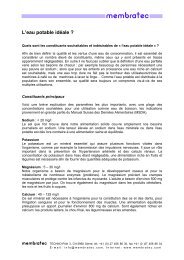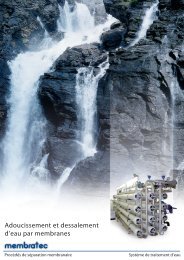Procédés reconnus destinés au traitement de l'eau potable
Procédés reconnus destinés au traitement de l'eau potable
Procédés reconnus destinés au traitement de l'eau potable
You also want an ePaper? Increase the reach of your titles
YUMPU automatically turns print PDFs into web optimized ePapers that Google loves.
3. Microorganismesindice c*tL’efficacité d’inactivation présentée<strong>au</strong> table<strong>au</strong> 3 est exprimée par l’indicec*t, à savoir le produit <strong>de</strong> la concentrationefficace <strong>de</strong> désinfectant c parla durée t d’exposition à ce produit.La durée d’exposition habituelle dansles stations <strong>de</strong> <strong>traitement</strong> est <strong>de</strong> 5 à10 minutes. Les concentrations endésinfectant doivent être adaptés à ladurée d‘exposition. Par analogie l’indicec*t, l‘efficience d‘une désinfection <strong>au</strong>moyen <strong>de</strong> rayons UV est donnée par ladose UV, établie sur la base <strong>de</strong> la puissancedu rayonnement et <strong>de</strong> la duréed‘exposition.Table<strong>au</strong> 3: comparatif <strong>de</strong>s procédés <strong>de</strong> neutralisation <strong>de</strong>s microorganismes basé sur l’indice c*t [mg*min/L]resp. la dose UV [J/m 2 ], qui permet d‘inactiver 99% <strong>de</strong>s microorganismes présents. La turbidité ete les substancescontenues dans l‘e<strong>au</strong> influencent fortement l‘efficacité <strong>de</strong> la désinfection. Les données portent surun pH neutre et une température <strong>de</strong> 5°C. Il s‘agit <strong>de</strong> valeurs indicatives. Si l’indice c*t manque, le signe (++)signifie que le procédé est bien adapté à la neutralisation. Par contre, le signe (-) signifie que le procédé estpratiquement inefficace.MicroorganismesNeutralisation (indices c*t, doses-UVresp. aptitu<strong>de</strong> à la neutralisation)Bacteries Chlore Dioxy<strong>de</strong> <strong>de</strong> chlore Ozone UVGermes aérobies mésophiles 0.08 0.13 0.02 ++Campylobacter jejuni ++ ++ ++ 34Entérocoques ++ ++ ++ ++Escherichia coli 0.03 - 0.05 0.04 - 0.08 0.01 - 0.02 30 - 80Salmonella ++ ++ ++ 20 - 120Shigella ++ ++ ++ 12 - 49Vibrio cholerae ++ ++ ++ 14VirusA<strong>de</strong>novirus 0.7 – 2.5 450 - 1050Enterovirus 1.1 – 4.0 6.7 – 12.8 0.1 – 0.8 70 - 180Norovirus +/- ++ ++ +Rotavirus 0.01 -0.05 0.2 – 2.1 0.01 – 0.06 150 - 190ProtozoairesCryptosporidium 510 - 7200 40 - 120 5 - 10 < 10 - 58Giardia 12 - 630 7.2 - 42 0.3 – 2.0 < 20 - 10016 | Traitement <strong>de</strong> l’e<strong>au</strong> <strong>de</strong>stinée à la consommation






